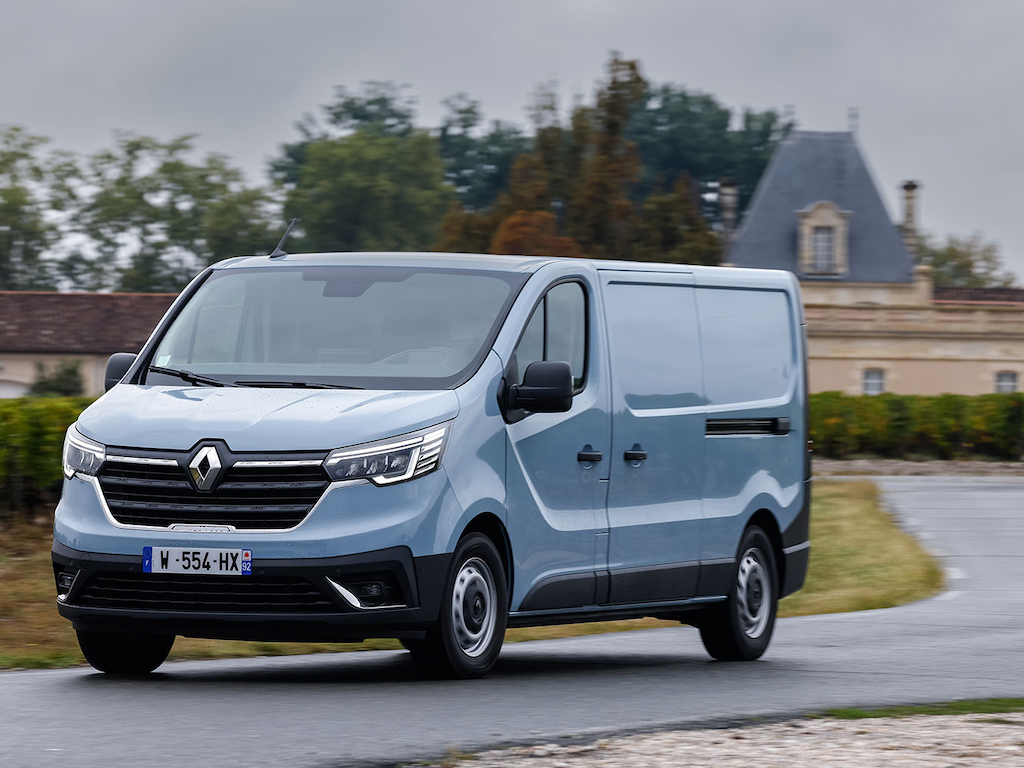Electric power comes to the Trafic, but has it been worth the wait? John Kendall finds out.
WHAT IS IT? An all-electric version of Renault’s latest-gen mid-sized Trafic van
MODEL TESTED? Renault Trafic Van E-Tech L2H1
PRICE? TBA
RANGE? Up to 184 miles (WLTP combined)
LOAD VOLUME? 6.7m3 (L2H1)
GROSS PAYLOAD? 950kg
DRIVE? 166hp/245Nm front-mounted drive motor, front-wheel drive with 52kWh under-floor battery packs
CHARGING? 22kW on-board charger. 80kW on-board DC rapid charger will become available in 2024
Renault revised the Trafic model range a year or two ago and gave the van a new lease of life, which it very much needed after Fiat and Vauxhall/Opel had left the joint venture that brought the original vehicle into being 23 years ago. Renault made a good job of modernising the van, but it was obviously missing an electric version, which the company has now put right.
As you would expect, Renault will launch the electric Trafic in phases. First to come is the longer L2 van variant, available with two roof heights as well as a chassis cab and crew cab van, with deliveries due to start in November. This will be followed by the shorter L1 variant in van and crew cab forms, with deliveries scheduled to start in December.
Like all other Trafic models, the E-Tech Electric will be made at Renault’s Sandouville plant, near Le Havre in northern France. The motor and chargers are produced at Renault’s plant in nearby Cléon in Normandy, battery assembly takes place at Flins and the electric conversion is carried out at Renault’s plant at Gretz-Armainvilliers.
The Trafic is powered by the same electric motor that is deployed in the Nissan Townstar electric van tested elsewhere in this issue (as well as the Renault Kangoo and Mercedes-Benz Citan electric variants), while its 52kWh battery pack is the same as that used in the Renault Master electric. The battery alone weighs 315kg.
It is a very tidy conversion too. Considering that the basic structure of the van dates from the late 1990s – in other words, it was never designed with an electrically powered variant in mind – you would not know it. The conversion was carried out to a high standard and it’s free from some of the electrical noise you find in other electric vehicles.
Our L2H1 test vehicles were loaded with a 300kg sample weight. Apart from settling the ride down, it was easy to forget it was there as the high torque output from rest – a characteristic of all electric vehicles – ensured that it made a minimal impact on performance. Our test vehicles were also equipped with a through loading bulkhead, stretching load length up to 4.15m for appropriately shaped items. Opting for the H2 roof will provide even more space – up to 8.9m3.
Ease of driving is a key characteristic of all electric vans, with no transmission to worry about and the lower noise levels which make driving them so much more relaxed. This is certainly the easiest Trafic to drive. If you are familiar with the modern Renault car range, you would feel instantly at home in the Trafic, which uses the same displays and switchgear as the cars and the Kangoo.
One thing we noticed is that despite the likeness with the Renault car range from the driving seat, the Trafic does not have a regenerative braking selector as would be found in the smaller Kangoo. In the Kangoo and the Renault electric car range, this is accessed using the gear selector. The explanation for this is that for the Trafic, regenerative braking is incorporated with the braking system, so regenerative braking is activated when pressing the brake pedal. Even so, if there is pressure from customers, Renault has said it would be prepared to re-think this and offer a system similar to that in the Kangoo.
The cab and dashboard are very similar to the diesel-powered Trafic variants. There is plenty of storage space in the cab, with large door pockets, glovebox, various storage spaces around the dashboard and storage space under the double passenger seat. The middle seatback also folds flat on the seat cushion to provide a tabletop.
Verdict
Trafic E-Tech Electric provides a good electric conversion of a familiar medium van. It offers competitive driving range, the familiarity of the Trafic range and the conversion is well executed.
In Brief
Key fleet model: Renault Trafic E-Tech L1
Pros: Good electric conversion of the Trafic carried out in-house
Cons: Lack of adjustment for regenerative braking
Seven-word summary: Good electric conversion of a familiar van









